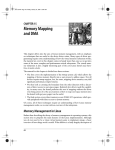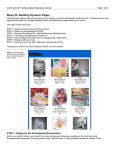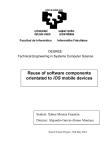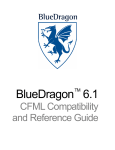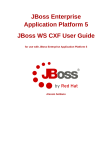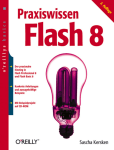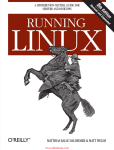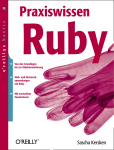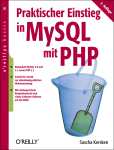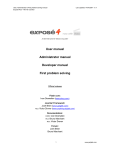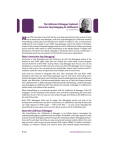Download MACROMEDIA FLASH REMOTING MX-USING FLASH REMOTING FOR FLASH MX 2004 ACTIONSCRIPT 2.0 Specifications
Transcript
Connecting Flash Applications to Remote Services
Flash
Remoting
The Definitive Guide
Tom Muck
Flash Remoting
The Definitive Guide
Other resources from O’Reilly
Related titles
oreilly.com
Programming ColdFusion MX
ActionScript for Flash MX
Pocket Reference
ActionScript for Flash MX:
The Definitive Guide
ActionScript Cookbook
oreilly.com is more than a complete catalog of O’Reilly books.
You’ll also find links to news, events, articles, weblogs, sample
chapters, and code examples.
oreillynet.com is the essential portal for developers interested in
open and emerging technologies, including new platforms, programming languages, and operating systems.
Conferences
O’Reilly & Associates brings diverse innovators together to nurture the ideas that spark revolutionary industries. We specialize
in documenting the latest tools and systems, translating the innovator’s knowledge into useful skills for those in the trenches.
Visit conferences.oreilly.com for our upcoming events.
Safari Bookshelf (safari.oreilly.com) is the premier online reference library for programmers and IT professionals. Conduct
searches across more than 1,000 books. Subscribers can zero in
on answers to time-critical questions in a matter of seconds.
Read the books on your Bookshelf from cover to cover or simply flip to the page you need. Try it today with a free trial.
Flash Remoting
The Definitive Guide
Tom Muck
Beijing • Cambridge • Farnham • Köln • Paris • Sebastopol • Taipei • Tokyo
Chapter 1
CHAPTER 1
Introduction to Flash Remoting
When I was an 11-year-old kid, I thought I was pretty good on a bike. I could do
wheelies around the neighborhood, drive on dirt hills, jump ramps. It wasn’t
enough, though. I wanted to make the transition to a minibike, which is basically a
little bike with a lawn mower engine on it. If all I needed was my riding skills, I probably would have been set. Unfortunately, keeping my feet in one place, turning the
throttle, and pressing the hand brakes on the minibike were unknown territories. My
first time out I turned the throttle too far, lost my footing, and forgot how to hit the
brake. I landed in a heap in the street.
If I had put a little forethought into it, I would have realized that riding a bike and
riding a minibike were completely different things. Only some aspects were the
same; by learning the new aspects and applying my prior knowledge of riding a bike,
I eventually figured out how to stay put without falling on my butt.
Working with a new computer technology in a familiar environment is like that. In
the case of Flash Remoting, everyone holding this book is probably familiar with
Flash movies and ActionScript programming. Flash Remoting puts some new and
exciting things into Flash that will require learning new ways to look at ActionScript
and what it can accomplish. With Flash Remoting, Macromedia has put an engine
on Flash.
What Is Flash Remoting?
These are exciting times. Macromedia is attempting to change the way application
developers create web-based applications.
Flash Remoting constitutes a complete rethinking of how web applications are constructed. Using Flash Remoting, you can create complex client/server applications
that more closely resemble desktop applications than traditional web pages. For
those of you familiar with traditional Windows-style programming IDEs, Flash
Remoting is roughly the web equivalent of a Visual Basic client/server application.
This chapter presents a broad overview of Flash Remoting.
3
This is the Title of the Book, eMatter Edition
Copyright © 2003 O’Reilly & Associates, Inc. All rights reserved.
Flash Remoting technology is at the center of Macromedia’s Studio MX product
suite, linking the server platforms with the client-side tools. Flash Remoting is built
into Macromedia’s two application servers—ColdFusion MX and JRun 4. In addition, programmers using other technologies, such as ASP.NET or J2EE application
servers, can purchase the Flash Remoting MX package so that Flash Remoting can be
utilized on those servers. Although Macromedia doesn’t officially support other languages, open source implementations are available for PHP (the AMFPHP project at
http://www.amfphp.org) and Perl (the FLAP project at http://www.simonf.com/flap).
There is also an open source Flash Remoting for Java implementation (OpenAMF at
http://www.openamf.org).
The Flash authoring environment includes UI components, which form the basis of
Macromedia’s strategy of using a Flash movie as the client in a client/server atmosphere. This approach allows the application server to provide the programming
power for the application. Using Flash Remoting, a Flash movie can act as the interface for diverse applications, including connections to databases, SMTP mailers,
server components, web services, and much more. Flash Remoting ties together the
Macromedia authoring tools and application server technologies to form a new
approach to web application development and deployment.
Flash Remoting is a server-side technology that integrates with existing application
servers to provide a gateway between the Flash Player and remote services deployed
on the server. A service can be a simple ColdFusion page or ColdFusion Component
(CFC), a PHP or Perl script, a Java class, or an ASP.NET page or DLL. Flash Remoting allows developers to access remote services and web services from within Flash
through a simple ActionScript API that is similar to JavaScript. Flash Remoting also
allows developers to integrate Flash with existing client/server applications with little modification, to provide a rich, robust user interface that can be deployed across
browsers, platforms, and devices.
The Flash Remoting gateway on the server sits between the Flash Player on the client and the server-side tier of an application. It handles data serialization and procedure calls between the Flash Player and the server. Serialization is the translation of
data to a format that can be easily transmitted over the Web. This translation is
transparent to both client-side Flash developers and server-side developers. We’ll
discuss a client/server architecture using the Flash Player and the Flash Remoting
gateway later in this chapter.
Using Flash Remoting, a Flash movie can connect to virtually any remote service
deployed on the server. The remote services can be deployed using various languages and technologies, including:
• Java classes
• JavaBeans™
• Enterprise JavaBeans (EJB)
4 |
Chapter 1: Introduction to Flash Remoting
This is the Title of the Book, eMatter Edition
Copyright © 2003 O’Reilly & Associates, Inc. All rights reserved.
• Java Management Extensions (JMX MBeans)
• ColdFusion templates
• ColdFusion Components
• Server-Side ActionScript (SSAS)
• ASP.NET pages
• ASP.NET DLLs
• SOAP-based web services
• PHP pages
In other words, a remote service might be a ColdFusion page, a PHP page, or an
ASP.NET DLL, among other things. Flash Remoting allows Flash to make remote
procedure calls on existing server-side services; server-side developers do not have to
implement any Flash-specific APIs or adjust their design patterns. Calling a service
from a Flash movie is as easy as calling it by name. For example, if you have a serverside method named getRecords( ) that you would typically call from another serverside page to feed an HTML page, Flash Remoting lets you call the getRecords( )
method directly from the Flash movie. Gone are the page reloads associated with
HTML pages. The communication with the server is seamless and invisible to the
user. This means that the typical web experience is much more user friendly and performs more like a traditional desktop application.
How Does Flash Remoting Work?
The Flash Remoting gateway is installed on the application server and acts as an
interface between the Flash Player and the server. The Flash Remoting software that
implements the gateway is also called an adapter. It has three main tasks:
• Handle requests from the Flash Player to remote services. These services can be
on the same server as the Flash Remoting gateway or can be external to the
server in the form of web services.
• Translate requests and data from the Flash Player into server-side requests and
datatypes.
• Translate responses and data from the server into native ActionScript datatypes.
Figure 1-1 depicts the Flash Player/Flash Remoting architecture.
Communication between the Flash Player and the Flash Remoting gateway is done
via HTTP, which has a few implications:
Communication between the Flash Player and the Flash Remoting gateway is
request-driven. The Flash Player must initiate all communication with the Flash
Remoting gateway. The server cannot push data to Flash unless it is requested
by the Flash Player. Use the ActionScript XMLSocket object, as discussed in
How Does Flash Remoting Work?
This is the Title of the Book, eMatter Edition
Copyright © 2003 O’Reilly & Associates, Inc. All rights reserved.
|
5
Flash Player
Client
Server
Flash Remoting
Application
server
Figure 1-1. The Flash Player/Flash Remoting architecture
ActionScript for Flash MX: The Definitive Guide (O’Reilly), if you need to push
data from the server to Flash, such as in a chat application. Another option is to
use Macromedia’s Flash Communication Server MX (FlashCom) for these types
of applications.
HTTP is a stateless protocol, so each request from the Flash Player opens a new
connection to the server. The Flash Remoting gateway automatically maintains
state between requests through the use of cookies. If cookies are not available on
the client, the session state is maintained through a header in the communication packets between the Flash Player and server.
Protocols that work with HTTP, such as SSL, also work with Flash Remoting.
As shown in Figure 1-2, the client/server architecture is the same when the Flash
Player communicates with Flash Remoting via HTTPS or SSL as it is using
HTTP. Support for HTTPS allows communication between the Flash Player and
the server to be encrypted using SSL, provided that the Flash movie is delivered
to the client over an SSL connection and displayed within an SSL-enabled
browser. This gives a Flash application the same level of security that is available to the HTML application.
Flash Player
Client
Server
SSL
Flash Remoting
Application
server
Figure 1-2. Flash Player/Flash Remoting architecture using SSL
6 |
Chapter 1: Introduction to Flash Remoting
This is the Title of the Book, eMatter Edition
Copyright © 2003 O’Reilly & Associates, Inc. All rights reserved.
Action Message Format
Flash 5 movies could send XML or name/value pairs across HTTP. Although these
packets could be parsed automatically by Flash or manually by the developer using
custom ActionScript, parsing could be slow because all XML data is sent as text
strings encased by cumbersome tags. Flash Remoting is able to handle complex
datatypes, such as objects, structures, arrays, and recordsets. A proprietary format
was needed to transfer information back and forth between the Flash movie and the
application server.
The protocol used for communication between the Flash Remoting gateway and the
Flash Player is Action Message Format (AMF). AMF is a binary protocol designed by
Macromedia to provide a lightweight, efficient means to serialize, deserialize, and
transport data between the Flash Player and the Flash Remoting gateway, as shown
in Figure 1-3.
Flash Player
HTTP post
AMF
AMF
HTTP response
Flash Remoting
Application
server
Figure 1-3. Flash Player/AMF/Flash Remoting
It is not necessary to understand AMF in detail to develop robust Flash applications
that utilize Flash Remoting; however, it is useful to have a basic understanding of the
protocol. Macromedia has not documented the protocol publicly, but the HTTP
packets can be examined to gain insight into the format, which seems to be closely
based on the format used in remote shared objects (RSOs). The developers of the
AMFPHP project have partially documented the format at:
http://amfphp.org/?g=amf_format
The Flash Player communicates with the Flash Remoting gateway via the AMF protocol sent via standard HTTP requests. An AMF packet is sent as a binary POST with
the body of the request containing the binary data serialization and remote procedure call information.
How Does Flash Remoting Work?
This is the Title of the Book, eMatter Edition
Copyright © 2003 O’Reilly & Associates, Inc. All rights reserved.
|
7
Flash Remoting requires browser support for binary POST. Because
Netscape 6.x does not support binary POST, Flash Remoting does not
work when the Flash Player is running within Netscape 6.x. The Flash
Remoting call has no effect and no error is returned. This bug is fixed
in Netscape 7. There are also issues with early versions of Safari and
Chimera on the Macintosh. You can use a browser-detecting script to
redirect users to an appropriate page that uses HTML or older Flash
formats if the user’s browser does not support your Flash Remoting
application.
An AMF packet consists of the following:
• A packet header, which describes the AMF version information and includes
HTTP headers
• A count of context headers in the array that follows
• The context headers array, which describes to the server the context in which the
information should be processed (on calls from the client) or describes to the client what is coming from the server (a result or status) and its format (such as a
recordset or a string)
• A count of the messages in the array that follows
• The messages array, which is typically a method call coming from the client or a
status/result coming from the server
Following is the HTTP request and response generated by the Hello World examples shown later in this chapter. Because AMF is a binary format, the binary data is
shown as periods (...). The ASCII text in the following excerpt, such as amf_server_
debug, is part of the literal message:
POST /flashservices/gateway HTTP/1.1
Referer: http://192.168.0.5:8500/flashservices/gateway
Content-Type: application/x-amf
User-Agent: Shockwave Flash
Host: 127.0.0.1
Content-Length: 198
Cache-Control: no-cache
.......amf_server_debug....pNetDebugConfig
coldfusion...
amfheaders....amf....
httpheaders....recordset....error....trace...m_debug.........
....*com.oreilly.helloworld.HelloWorld.sayHello.../1....
And the response from the server back to the Flash Player is as follows:
HTTP/1.0 200 OK
Date: Thu, 23 May 2002 02:53:09 GMT
Content-Type: application/x-amf
Content-Length: 69
Server: JRun Web Server
8 |
Chapter 1: Introduction to Flash Remoting
This is the Title of the Book, eMatter Edition
Copyright © 2003 O’Reilly & Associates, Inc. All rights reserved.
.....
/1/onResult...null.....
Hello World from ColdFusion Component
We can gain some insight into AMF by examining the request and response:
• The content type of AMF is application/x-amf.
• The AMF data is contained within the body of the request and response; it is primarily binary and is therefore difficult to show in print.
• There are human-readable strings within the AMF data.
The last point tells us that AMF is not entirely compressed. However, even uncompressed, the protocol is very efficient at serializing ActionScript data.
AMF has a number of advantages over traditional Flash data serialization techniques, such as XML and URL-encoded query strings, including:
• AMF is a binary format and thus creates serialized data that is smaller than using
string-based encoding. This translates into lower bandwidth requirements and
faster loading and response times.
• AMF was built specifically with Flash ActionScript datatypes in mind. Therefore, it can be serialized quickly and efficiently from ActionScript objects and
deserialized into ActionScript objects within the Flash Player. In almost all cases,
this leads to significant performance increases over string-based serialization.
Why does Flash Remoting use AMF instead of SOAP to communicate with the Flash
Player? After all, SOAP was designed as a lightweight protocol for the exchange of
information in a distributed environment, which sounds similar to the goals for
AMF. Both SOAP and AMF can transfer data and make calls on remote services, and
both work over standard HTTP and HTTPS. There are several reasons why Macromedia developed AMF instead of using SOAP:
• SOAP is implemented as XML and is therefore rather verbose compared to the
binary AMF.
• AMF is designed and optimized to work with Flash ActionScript datatypes.
Deserializing AMF in the Flash Player is much more efficient than parsing and
deserializing SOAP, because AMF has direct support for ActionScript datatypes
whereas SOAP is a general-purpose protocol. Even if SOAP messages were compressed, serialization in AMF would still be more efficient.
• Adding AMF support to Flash Player 6 required only a small increase in the
Player size (about 4 KB compressed), maintaining its slim footprint.
• Integrating full SOAP support on the client side, with acceptable performance,
requires an increase in Player size. Although Flash Player 6 includes XML support, it does not support some headers required by SOAP. Using Flash Remoting, Flash can access SOAP-based web services even though Flash Player 6
doesn’t support SOAP directly. That is, the Flash Remoting gateway translates
SOAP requests to and from AMF format on the server-side and then uses AMF
How Does Flash Remoting Work?
This is the Title of the Book, eMatter Edition
Copyright © 2003 O’Reilly & Associates, Inc. All rights reserved.
|
9
to communicate with the Flash Player. Flash Player 7 supports SOAP directly,
but it will be late 2004 until Flash Player 7 is widely distributed.
The body of the AMF packet contains either an onResult event (i.e., response event)
or an onStatus event (i.e., error event), which are both ActionScript objects. The
Flash movie can then use the object directly, without any further parsing. Chapter 3
contains an in-depth discussion of the onStatus and onResult events.
Benefits
One of the key benefits of using Flash Remoting over XML or traditional HTML
applications is that the application server no longer needs to handle any of the parsing or presentation of information. This frees resources on the server so that it can be
better equipped to deal with more complex application logic and/or more users. In
addition, session management can be handled on the client inside of the Flash movie
rather than on the server. The server still keeps track of the session, but the developer doesn’t have to jump through hoops to keep track of users who don’t have
cookies or track a user session across multiple pages. This equates to huge savings in
development time and server resources.
Why Not XML?
I’ve talked about the benefits of Flash Remoting, but why not use XML? After all,
using XML you could encapsulate all of the client/server communication within an
ActionScript object and provide a simple API to transfer complex datatypes serialized with XML between Flash and the server. This would have the advantage of not
requiring a server-side gateway and would work with Flash Player 5.
The main advantage of Flash Remoting over XML is that it relieves the developer
from writing an entire layer of code on both the client and server. XML parsing is
built into many of the popular server technologies, but it is cumbersome at best.
However, Flash Remoting also has a number of additional advantages:
• It automatically handles all datatype conversions between ActionScript and the
server.
• It can convert multiple complex datatypes.
• It seamlessly supports multiple server-side technologies and application servers.
• It allows remote services and web services to be called directly from Flash without requiring any additional server-side code to be written.
• It provides a simple and consistent API for calling remote services and web services from the Flash Player.
• It uses AMF to serialize data, which offers better performance than string-based
serialization techniques (such as XML), even though AMF is not as widely supported as XML.
10 |
Chapter 1: Introduction to Flash Remoting
This is the Title of the Book, eMatter Edition
Copyright © 2003 O’Reilly & Associates, Inc. All rights reserved.
In a typical scenario involving an XML object being sent from a Flash 5 movie to a
ColdFusion page, the Flash movie first has to create the XML string manually. Then
it has to send the XML string to the ColdFusion page, which has to parse the XML
before being able to utilize it. In addition, the server has to transform the result of
any operation on the server back into XML to send the result to the Flash movie. The
Flash movie then has to parse this XML once again to use the returned information.
All of this parsing of data eats up valuable resources and bandwidth even before the
application logic can be utilized.
In other words, a Flash 5 movie can’t use the data directly from the application
server, and the application server can’t use the data directly from Flash 5.
Take a typical example of a username and password login. The ActionScript for the
Flash movie could create a simple XML string and pass it to the ColdFusion page:
// Set up a new XML object.
var returnXML = new XML( );
returnXML.ignoreWhite = true;
// Set the callback function for the response from the server.
returnXML.onLoad = handleReply;
// Create an XML string.
// Form field variables are replaced in the string.
var my_xml = '<?xml version="1.0" encoding="iso-8859-1"?>';
my_xml += '<myValidation>';
my_xml += '<username>' + username + '</username>';
my_xml += '<password>' + password + '</password>';
my_xml += '</myValidation>';
var flash_xml_object = new XML(my_xml)
// Send it to the server and then load it into the my_xml object.
flash_xml_object.sendAndLoad("http://192.168.0.4/myLogin.cfm", returnXML);
function handleReply (result) {
if (result) {
if (this.firstChild.attributes.logged == "1") {
greeting = "Hello " + this.firstChild.attributes.username;
greeting += ". Login was successful";
} else {
greeting = "Login failed";
}
} else {
greeting = "There was a communication failure.";
}
}
A ColdFusion page to handle the logic would look like this:
<!---Deserialize the username and password from the XML--->
<cfset logged="1">
<cfset my_xml = XMLParse(URLDecode(GetHttpRequestData( ).content))>
<cfset username = my_xml.myValidation.username.xmltext>
<cfset password = my_xml.myValidation.password.xmltext>
Benefits
This is the Title of the Book, eMatter Edition
Copyright © 2003 O’Reilly & Associates, Inc. All rights reserved.
|
11
<!---Query the database for matching entries--->
<cfquery name="myLogin" datasource="myDatasource">
SELECT username FROM Users
WHERE username = '#username#' and password = '#password#'
</cfquery>
<!---Check whether a match was found--->
<cfif myLogin.RecordCount LT 1>
<cfset logged = "0">
</cfif>
<!---Create an XML string to return to the Flash movie--->
<cfset returnXML = "<return username=""" & username>
<cfset returnXML = returnXML & """ logged=""" & logged & """ />">
<cfoutput>#returnXML#</cfoutput>
As you can see, the code is not intuitive—the XML is manually serialized into a
string on both client and server, and the string has to be deserialized and turned into
an XML object again on the Flash side. All of this code was created to send one simple XML object from the Flash movie to the server and back again. Imagine if this
were something more complex, such as a recordset with 10 or 15 fields and 1,000
rows.
The Flash Remoting version of the previous code might look like this:
var myURL = "http://127.0.0.1/flashservices/gateway";
var myServer = NetServices.createGatewayConnection(myURL);
var myService = myServer.getService("com.oreilly.frdg.authentication", this);
myService.getLogin(username, password);
// The result handler for the getLogin( ) method invocation
function getLogin_Result (result_rs) {
if (result_rs.getLength( ) < 1) {
greeting = "Login failed";
} else {
greeting = "Hello " + result_rs.getItemAt(0).username;
greeting += ". Login was successful";
}
}
And the server-side code might look like this:
<cfcomponent displayName="login">
<cffunction name="getLogin" returnType="query" access="remote">
<cfargument name="username" type="string">
<cfargument name="password" type="string">
<cfquery name="myLogin" datasource="myDatasource">
SELECT username FROM Users
WHERE username = '#username#' and password = '#password#'
</cfquery>
<cfreturn myLogin>
</cffunction>
</cfcomponent>
12 |
Chapter 1: Introduction to Flash Remoting
This is the Title of the Book, eMatter Edition
Copyright © 2003 O’Reilly & Associates, Inc. All rights reserved.
The Flash Remoting code in this version is more intuitive; it defines a component
containing a function that accepts two arguments directly from Flash. There is no
manual parsing; the arguments to the function are passed as strings and a recordset
is returned. If the recordset contained 15 fields and 1,000 rows, the server-side code
would not look much different.
Using Flash Remoting is much simpler because the Flash movie does not have to
package the request in any special format such as XML. Likewise, the ColdFusion
Server does not have to package the result for the Flash movie. The data is simply
passed back and forth as is and put to use. It is the difference between having a pizza
delivered and making the dough and baking the pizza yourself. If the pizza is delivered, the only action you have to take on the pizza is to eat it.
Manually serializing and deserializing data has the advantage of working with Flash
Player 5. However, when you consider the amount of client- and server-side code
that you have to write, debug, and maintain just to provide basic support for serializing one datatype, the advantages of Flash Remoting become clearer. Considering all
the datatypes that Flash Remoting supports and the fact that you can call remote services by name without writing any extra server-side code, Flash Remoting becomes
quite attractive.
HTML and Server-Side Code
A typical HTML/server-side template application has problems similar to those in
our XML example. The server-side code does not simply perform logic and return
information; in many cases, it formats the data as well. Take this simple ColdFusion
snippet as an example:
<!---Query the database for matching entries--->
<cfquery name="rsGetSearchResults" datasource="bookstore">
SELECT Title, Category, Pub_No FROM Books
WHERE Title LIKE '%#form.searchfield#%'
</cfquery>
<!---Create an HTML table to display the matches--->
<table border="1">
<tr>
<td>Title</td>
<td>Category</td>
<td>Pub_No</td>
</tr>
<cfoutput query="rsGetSearchResults"
startRow="#StartRow_rsGetSearchResults#"
maxRows="#MaxRows_rsGetSearchResults#">
<tr>
<td>#rsGetSearchResults.Title#</td>
<td>#rsGetSearchResults.Category#</td>
<td>#rsGetSearchResults.Pub_No#</td>
</tr>
</cfoutput>
</table>
Benefits
This is the Title of the Book, eMatter Edition
Copyright © 2003 O’Reilly & Associates, Inc. All rights reserved.
|
13
This example queries a database and outputs the results as a table in the browser.
This type of mixture of HTML and server-side code is commonplace in web application development. Notice, however, that the presentation of the content is created
entirely by the application server. The HTML table doesn’t exist until the query is
executed and the results are sent to the browser.
Using Flash Remoting, the application server code is utilized for the logic only—querying the database. The results of the query are returned to the Flash movie without
any further parsing or manipulating. Using Flash Remoting, a ColdFusion component could be written as follows:
<cfcomponent displayName="searchBooks">
<cffunction name="getTitles" returnType="query" access="remote">
<cfargument name="search" type="string" default="%" />
<cfquery name="rsGetSearchResults" datasource="bookstore">
SELECT Title, Category, Pub_No FROM Books
WHERE Title LIKE '%#form.searchfield#%'
</cfquery>
<cfreturn rsGetSearchResults />
</cffunction>
</cfcomponent>
Notice the line in bold, <cfreturn rsGetSearchResults />, which returns the entire
recordset to the Flash movie as an ActionScript RecordSet object. The Flash movie, in
turn, can use the recordset without any further parsing. For example, to attach the
recordset to a DataGrid component in Flash, you can simply use this result handler
in ActionScript:
function rsGetSearchResults_Result (result_rs) {
myGridComponent.setDataProvider(result_rs);
}
Again, the Flash movie is working with the recordset as it comes from the server. No
further parsing is necessary. Also, the ActionScript programmer has at his disposal a
series of highly complex and interactive interface elements, unlike HTML forms,
which are limited in functionality.
Another advantage is that the Flash movie looks the same in all browsers. The
HTML language is ubiquitous, but the implementation is not uniform. Typically,
you have to rely on CSS implementation, JavaScript being enabled, and/or cookies
being enabled, or you have to create even more client-side code to handle the many
possible user configurations.
Session Management in Flash
HTTP is a stateless protocol. The web server treats each page request coming from a
browser as coming from an entirely new user. To create the illusion of maintaining
state, many application servers have state management (or session management) in
place to create a seamless experience for the end user. Session management is a bit of
14 |
Chapter 1: Introduction to Flash Remoting
This is the Title of the Book, eMatter Edition
Copyright © 2003 O’Reilly & Associates, Inc. All rights reserved.
an art form for the application developer, as there are no sure-fire, out-of-the-box
methods to maintain state in most application servers.
Typically, in a web application, you use cookies in conjunction with session variables to maintain state. This method won’t work if cookies are turned off on the client’s browser; therefore, you must store the information in a database or text file for
100% reliability. Furthermore, session management and variables eat up server memory. In an ASP application, for example, each typical user session consumes at least
4.5 KB, unless sessions are explicitly turned off. Also, unless a server application is
cluster-aware, managing session state across a cluster can become complicated
(because different servers in the cluster might handle successive requests).
Flash Remoting handles session state through means that are invisible to both the
user and the server. Session information is sent with each and every AMF packet
between the client and the server. No manual session management is required. In a
rich client implementation, the Flash movie is loaded into the user’s browser only
once, so session state is maintained automatically with every call to the server. In
addition, because the session state is maintained within the Flash movie in the user’s
browser, it makes little difference if the application server is clustered.
Flash Remoting Requirements
To develop Flash applications that use Flash Remoting, you must have:
• Macromedia Flash MX or later
• The Macromedia Flash Remoting components
• A server that has the Flash Remoting gateway or the equivalent (such as
AMFPHP, FLAP, or OpenAMF)
Macromedia Flash Authoring Tool
The Flash authoring environment is used to create Flash files (.fla and .swf files) and
applications. Flash MX was a substantial upgrade to previous versions of Flash. In
addition to cosmetic interface changes, the way in which Flash applications are
developed has changed. Flash MX or later is required to develop Flash Remoting
applications. A fully functional trial version is available from Macromedia at:
http://www.macromedia.com/software/flash/download/
You can find more information on Flash at:
http://www.macromedia.com/software/flash/
As of Flash MX, Macromedia abandoned a consistent versionnumbering scheme for the authoring tool, but the Flash Player is still
assigned a numeric version. Flash Remoting requires that you publish
your .swf files in Flash 6 format or later.
Flash Remoting Requirements
This is the Title of the Book, eMatter Edition
Copyright © 2003 O’Reilly & Associates, Inc. All rights reserved.
|
15
Director MX, a separate multimedia authoring tool sold by Macromedia, can access
Flash Remoting using the Flash MX Asset Xtra (which is basically an embedded version of Flash Player 6). For simplicity, this book assumes you are running Flash in a
browser or a standalone Projector.
Macromedia Flash Remoting Components
Flash MX does not come with the Flash Remoting components preinstalled. The
Flash Remoting components add support for Flash Remoting to the Flash authoring
environment and are required to create Flash files that take advantage of Flash
Remoting. If you’re using Director MX as the front end, you’ll need the Flash MX
Asset Xtra, which is compatible with Director MX or Shockwave 8.5.1 or later. The
Flash MX Asset Xtra includes Flash Remoting support.
The Flash Remoting components are included with the Flash Remoting gateway and
can be found on the Studio MX CD-ROM or downloaded for free from the Macromedia web site. If you’re using versions from the Studio MX CD-ROM, make sure
you get the latest updates from the Macromedia site as well. The components and
other information about Flash Remoting can be found at:
http://www.macromedia.com/go/flashremoting
The components make the following items available from within the Flash MX
authoring environment:
• ActionScript code and classes necessary for Flash Remoting, including NetServices.as, RecordSet.as, DataGlue.as, and NetDebugger.as
• The Remote Service Browser, for examining remote services
• The NetConnection Debugger panel, for debugging Flash Remoting applications
• Flash MX ActionScript editor enhancements for Flash Remoting, and Reference
panel documentation
All of these items are discussed in detail in this book, beginning in Chapter 2.
Macromedia Flash Remoting Gateway
The Flash Remoting gateway must be installed on the remote server to allow it to
communicate with the Flash movie via Flash Remoting. If you are using an application server that comes with Flash Remoting preinstalled, such as ColdFusion MX or
JRun 4, then this step is already taken care of.
Earlier versions of ColdFusion and JRun do not support Flash Remoting.
16 |
Chapter 1: Introduction to Flash Remoting
This is the Title of the Book, eMatter Edition
Copyright © 2003 O’Reilly & Associates, Inc. All rights reserved.
The Flash Remoting gateway is also sold separately for other application servers,
including J2EE servers and Microsoft .NET, and must be installed and configured
before it can be used. The trial version of the Flash Remoting gateway for J2EE and
ASP.NET can also be downloaded from the Macromedia web site cited earlier.
There are several open source implementations of the Flash Remoting gateway, apart
from the versions supported by Macromedia.
The AMFPHP project, discussed in Chapter 9, implements Flash Remoting for PHP
application servers:
http://www.amfphp.org
The FLAP project implements Flash Remoting for Perl:
http://www.simonf.com/flap
The OpenAMF project is an open source alternative to Macromedia’s Flash Remoting gateway for Java:
http://www.openamf.org
Supported Platforms
This section is a quick summary of Flash Remoting capabilities and server-side services that can be exposed to Flash from supported application servers. For the latest
list of supported application servers, platforms, and configurations, see:
http://www.macromedia.com/go/flashremoting
Macromedia ColdFusion MX
The Flash Remoting gateway comes preinstalled with Macromedia ColdFusion MX
and allows developers to deploy remote services as:
• ColdFusion pages
• ColdFusion Components
• Server-Side ActionScript (SSAS)
• SOAP-based web services
Flash Remoting is also included in the Macromedia ColdFusion MX for J2EE version for deployment on Java application servers, such as WebSphere and BEA
WebLogic. It includes support for the remote services supported in ColdFusion MX
in addition to those supported on a Java server that ColdFusion is installed on, as
discussed below. For more information on ColdFusion MX, or to download a fully
functional trial version, go to:
http://www.macromedia.com/software/coldfusion/
Supported Platforms
This is the Title of the Book, eMatter Edition
Copyright © 2003 O’Reilly & Associates, Inc. All rights reserved.
|
17
See also Programming ColdFusion MX, by Rob Brooks-Bilson (O’Reilly), for information on ColdFusion. The trial/developer version of ColdFusion MX can be obtained
together with Flash MX in the Macromedia Studio MX bundle.
J2EE Application Servers and Java Servlet Engines
The Flash Remoting gateway is available as a standalone product for any J2EEcompatible application server. It also works with a Java servlet engine that has been
certified compatible with Sun’s servlet 2.2 or 2.3 specifications, such as Tomcat.
Flash Remoting for J2EE allows remote services to be deployed as:
• JavaBeans
• Java classes
• Enterprise JavaBeans
Macromedia has tested the functionality with J2EE servers such as JRun 4, IBM
WebSphere AS 4, and Sun ONE Web Server, although they also mention reports of
success with Tomcat and other servers. For the latest information on supported
application servers, consult the Flash Remoting documentation at the Macromedia
site.
Chapter 7 discusses Flash Remoting for J2EE servers in detail. The OpenAMF
project, an alternative to Macromedia Flash Remoting gateway for J2EE, is also discussed briefly at the end of Chapter 7.
Macromedia JRun 4
JRun is Macromedia’s J2EE-compliant Java application server. Flash Remoting
comes preinstalled with Macromedia JRun 4 and allows developers to deploy remote
services as:
• JavaBeans (stateful)
• Java classes (no state and no pool, new instance on every request)
• Enterprise JavaBeans (EJBHome and EJBObject)
• JMX MBeans
• Server-Side ActionScript (SSAS)
• SOAP-based web services
Because JRun 4 is a J2EE-based server, it supports access to the same services as
other J2EE-compatible application servers mentioned earlier, as well as Server-Side
ActionScript, JMX MBeans, and SOAP-based web services. For more information on
JRun, or to download a fully functional trial version that will revert to a developer’s
version after 30 days, go to:
http://www.macromedia.com/software/jrun/
18 |
Chapter 1: Introduction to Flash Remoting
This is the Title of the Book, eMatter Edition
Copyright © 2003 O’Reilly & Associates, Inc. All rights reserved.
Microsoft ASP.NET Servers
Flash Remoting is available as a standalone product for Microsoft ASP.NET servers.
It allows remote services to be deployed as:
• ASP.NET pages (.aspx pages)
• DLL libraries (in the local assembly cache)
• .NET executables
• SOAP-based web services
Flash Remoting does not work with “classic” ASP pages. You must
have the ASP.NET framework running on your server. To run the
ASP.NET framework you need IIS 5.0 or later, running on Windows
2000 Professional, Windows 2000 Server, Windows XP Professional,
or Windows Server 2003 (a.k.a. Windows .NET Server).
Hello World
An introduction to any technology would not be complete without a “Hello World”
example. This will give you some hands-on experience with the client-side and
server-side code before diving into details. It also provides a sound basis for exploring Flash Remoting on your own.
First, we will look at the Flash code necessary to call the remote service, which is virtually the same regardless of which server-side technology implements the service.
We will then look at the server-side code implemented in ColdFusion, Server-Side
ActionScript, Java, ASP.NET, PHP, and as a SOAP-based web service.
The examples throughout the book assume that you have Flash
Remoting installed and configured on your server, and that you have
installed the Flash Remoting components for Flash MX. Chapter 2
covers Flash Remoting installation and configuration in more detail.
Flash ActionScript Code
The client-side ActionScript is virtually the same for each server-side service example. The only things that change are the path to the remote service when it is implemented as a web service and the path to the Flash Remoting gateway, which varies
depending on the server implementation.
The client-side ActionScript code shown in Example 1-1 should be inserted on the
first frame of the main timeline of a Flash movie, as shown in Figure 1-4.
Hello World
This is the Title of the Book, eMatter Edition
Copyright © 2003 O’Reilly & Associates, Inc. All rights reserved.
|
19
Figure 1-4. Flash timeline with attached client-side ActionScript
Example 1-1. Client-side ActionScript code (HelloWorld.fla)
/*** Section 1 ***/
#include "NetServices.as"
/*** Section 2 ***/
// Assign myURL so it points to your Flash Remoting installation.
var myURL = "http://localhost/flashservices/gateway";
var myServicePath = "com.oreilly.frdg.HelloWorld";
/*** Section 3 ***/
myResult = new Object( );
myResult.onResult = function (data) {
trace("Data received from Server : " + data);
};
myResult.onStatus = function (info) {
trace("An error occurred : " + info.description);
};
System.onStatus = myResult.onStatus;
/*** Section 4 ***/
var myServer = NetServices.createGatewayConnection(myURL);
20 |
Chapter 1: Introduction to Flash Remoting
This is the Title of the Book, eMatter Edition
Copyright © 2003 O’Reilly & Associates, Inc. All rights reserved.
Example 1-1. Client-side ActionScript code (HelloWorld.fla) (continued)
var myService = myServer.getService(myServicePath, myResult);
myService.sayHello( );
Section 1 of Example 1-1 includes the NetServices.as library, which contains the code
necessary to connect to a Flash Remoting–enabled server from Flash. If you do not
include NetServices.as, the example will not work, but you will not receive any errors
within the authoring environment.
Section 2 initializes two variables: myURL and myServicePath. The myURL variable will
be used to create a NetConnection object that points to the server. The myServicePath
variable will be used to create a service object that points to the service that will be
called.
The myURL variable specifies the URL to the Flash Remoting gateway installed on the
server. If the Flash Remoting gateway is installed on a Microsoft .NET server, the
URL will point to the .aspx file for the gateway. Similarly, if you are using AMFPHP,
the URL will point to a gateway.php file on your server.
The myServicePath variable specifies the path on the server to the remote service that
will be called. The naming convention is similar to a Java package, with each section
representing a directory on the server and the last section pointing to the actual service. If the remote service is a Microsoft .NET DLL, myServicePath should refer to
the DLL’s namespace and class name. Similarly, if the remote service is a Java class,
the myServicePath variable will refer to the package name and class name of the Java
class. If the remote service is a web service, myServicePath should contain the path to
the web service’s WSDL file.
Calls from the Flash Player to the application server via the Flash Remoting gateway
are asynchronous. Code execution within the Flash Player continues while data is
being loaded, which is similar to loading XML into the Flash Player. You must define
callback functions, which will be called automatically when the data loads from the
server.
A callback function is a function that is called when a specific event
occurs. For example, attaching a callback function to an object’s
onClick property causes the callback function to execute whenever the
object is clicked. Similarly, a remote service call causes a specific event
to occur, which can have a callback function associated with it.
In ActionScript, callback functions can be attached as properties to a generic object
(instantiated from the Object class). The functions are used to catch data and messages sent back from the server.
Section 3 of Example 1-1 creates an object and attaches two callback functions to it.
The onResult( ) callback function is called when data is returned from the remote
Hello World
This is the Title of the Book, eMatter Edition
Copyright © 2003 O’Reilly & Associates, Inc. All rights reserved.
|
21
service, and the onStatus( ) callback function is called if an error occurs. An object
used to receive results from a remote service is called a responder object (or sometimes called a response object).
Another way to trap events is to specify callback functions named the
same as the service name with _Result and _Status appended to it. This
technique, along with more information about callback functions and
responder objects, is covered in Chapters 3 and 4.
The System.onStatus property specifies the function to be called if the Flash Player
cannot connect to the server, as these types of errors are not handled by the onStatus( )
callback function for the remote service call. Example 1-1 sets System.onStatus to execute our object’s onStatus( ) function. Once we have created an object and the callback functions to receive and process the data returned from the server, we are ready
to call the remote service.
Section 4 of Example 1-1 makes a connection to the server by passing in myURL (initialized earlier) to the NetServices.createGatewayConnection( ) function. The server
connection information is stored in the myServer variable. The example then gets a
reference to the remote service, which we store in the variable myService, by calling
the getService( ) method on the myServer variable initialized in the previous step. In
the call to getService( ), we pass myServicePath to access the desired service and pass
our myResult object to catch the data or status when the operation completes. We
can then use myService (the reference to the remote service) to call methods on the
service, such as the sayHello( ) method.
The path passed to getService( ), as specified by myServicePath, does
not include a file extension for the remote service. Therefore, Flash
can access a remote service without knowing its implementation
details. One of the powerful aspects of Flash Remoting is that it makes
almost all server-side services accessible in a uniform manner. However, you cannot automatically detect which remote services are available. That is, you need to know the remote service methods you
intend to call. Flash Remoting has no mechanism in place to find
unknown remote services on the fly.
Save the Flash movie as HelloWorld.fla. Before the movie can be tested, we need to
create the server-side code that implements the sayHello( ) function, as described in
subsequent sections.
Example 1-1 utilizes the trace( ) command to display the data in the Output window
in the Flash authoring environment. Therefore, the output is visible only when the
movie is tested in the authoring environment and not when tested in a browser.
22 |
Chapter 1: Introduction to Flash Remoting
This is the Title of the Book, eMatter Edition
Copyright © 2003 O’Reilly & Associates, Inc. All rights reserved.
Server-Side Code
In the next section, you’ll create the remote service required by this simple Flash
movie. Once you have created the remote service, you can test the Flash movie using
Control ➝ Test Movie. You should get the following output displayed in the Output
window:
Data received from Server : Hello World from servertype
If you do not get this result:
• Set the Output window to verbose mode (Window
Debug Level ➝ Verbose).
➝
Output
➝
Options
➝
• Make sure that the server where the Flash Remoting gateway is installed is running and accessible.
• Make sure that there are no syntax errors in your client-side ActionScript code or
server-side code.
ColdFusion MX
For the ColdFusion MX example, we will implement the remote service as a ColdFusion Component (CFC). CFCs are new to ColdFusion MX and provide an objectbased approach to ColdFusion development. They are ideally suited to Flash
Remoting. CFCs are discussed in depth in Chapter 5.
Create a file named HelloWorld.cfc and place it into the following directory, where
webroot is the root of your web server and com\oreilly\frdg\ matches the service path
specified by the initial portion of the myServicePath variable in Example 1-1:
webroot\com\oreilly\frdg
Example 1-2 shows the code that must be added to your HelloWorld.cfc component:
Example 1-2. ColdFusion code for HelloWorld.cfc
<cfcomponent>
<cffunction name="sayHello" access="remote" returntype="string">
<cfreturn "Hello World from ColdFusion Component" />
</cffunction>
</cfcomponent>
This is a simple component that contains one function, sayHello( ), which returns a
string. Notice that we set the access to "remote", which is necessary to allow the
component to be called remotely, either by Flash or as a web service.
Save the component. If you have access to the ColdFusion administrative interface
(which you should if you have a local installation) browse to it through your browser
with the following URL:
http://yourservername/com/oreilly/frdg/HelloWorld.cfc/
Hello World
This is the Title of the Book, eMatter Edition
Copyright © 2003 O’Reilly & Associates, Inc. All rights reserved.
|
23
After entering your ColdFusion administrative password, you should see a description of the component, similar to Figure 1-5.
Figure 1-5. ColdFusion MX component description autogenerated by ColdFusion MX
If you do not see the description, or if you get an error, check and fix any syntax
errors and try again.
Once you have verified that the ColdFusion component works via the browser,
switch back to Flash and test the HelloWorld.fla movie created in Example 1-1. You
should see “Hello World from ColdFusion Component” in Flash’s Output window.
Server-Side ActionScript
ColdFusion MX and JRun 4 application servers allow developers to create remote
services in Server-Side ActionScript (SSAS). Server-Side ActionScript is a scripting language that a Flash MX developer can use to create remote services without needing
to know a server-side language such as ColdFusion Markup Language (CFML) or
Java. Client-side JavaScript and ActionScript programmers may find SSAS easier than
learning a new language. Using SSAS, simple services can be written that access databases or utilize the HTTP functionality of ColdFusion or JRun 4. Code written in
24 |
Chapter 1: Introduction to Flash Remoting
This is the Title of the Book, eMatter Edition
Copyright © 2003 O’Reilly & Associates, Inc. All rights reserved.
SSAS can be consumed by Flash via Flash Remoting only and cannot be used to create other types of output such as HTML.
The SSAS mechanism of ColdFusion MX and JRun 4 is actually a server-side implementation of the Rhino JavaScript parser, with some server-specific objects and
methods added that allow the developer access to the functionality of <cfquery> and
<cfhttp> tags of ColdFusion (found in the ActionScript CF object). Methods of the
CF object can be accessed as CF.methodName( ). You can find a complete discussion of
SSAS in Chapter 6. See http://www.mozilla.org/rhino/ for details on the Rhino project.
To implement the Hello World example in SSAS, create a plain text file named
HelloWorld.asr using any text editor, and place it into the following directory, where
webroot is the root of your web server:
webroot/com/oreilly/frdg/
The code in an SSAS (.asr) file is not compiled or encrypted. If a user
browses to an .asr file, the browser displays the code as plain text
unless you take steps to prevent it at the web server level. You should
turn off read permissions for .asr files in your web server or keep the
files in a secured directory.
Since ColdFusion can process CFCs, ColdFusion pages, and SSAS files, you need to
make sure there are no name conflicts. If you created the ColdFusion component
example file earlier, rename HelloWorld.cfc to SomethingElse.cfc to ensure that the
SSAS (.asr) file, and not the ColdFusion file, is processed. You may also need to
restart the ColdFusion MX server, as the .cfc file may have been cached. The exact
order in which services are located varies with the application server on which the
Flash Remoting gateway is installed. See the appropriate server chapters later in the
book for details.
Example 1-3 shows the code that should be added to HelloWorld.asr; it creates a
simple function called sayHello( ) that returns a string to the client.
Example 1-3. Server-Side ActionScript code for HelloWorld.asr
function sayHello ( ) {
return "Hello World from Server-Side ActionScript";
}
Save the file in plain text format and switch back to Flash. Test the Flash movie and
you should see the output from the SSAS function.
If you get an error saying that the service cannot be found, check the service path,
and make sure that there are no syntax errors in the .asr file.
Hello World
This is the Title of the Book, eMatter Edition
Copyright © 2003 O’Reilly & Associates, Inc. All rights reserved.
|
25
Java using JRun 4 or other J2EE servers
For the Java example, we will implement our remote service as a simple Java class.
Using Java as a remote service requires that the Flash Remoting gateway be installed
on a Java application server such as Macromedia’s JRun 4 or IBM’s WebSphere. The
Java version will not work with ColdFusion MX or Microsoft .NET servers.
Create a new plain text file in any text editor, name it HelloWorld.java, and enter the
code shown in Example 1-4.
Example 1-4. Java code for HelloWorld.java
package com.oreilly.frdg;
public class HelloWorld {
public String sayHello ( ) {
return "Hello World from Java";
}
}
Compile the class into your web server’s classpath. This may vary from server to
server, but the server’s WEB-INF (or SERVER-INF in the case of JRun) directory is
usually included within the server’s classpath. For example, to compile it using JRun
4, you would use (from a command prompt):
c:\jrun4\servers\myservername\server-inf\classes\com\oreilly\frdg\>javac
HelloWorld.java
If you are using JRun 4 and created the SSAS example earlier, rename HelloWorld.asr
to SomethingElse.asr to ensure that the Java class is used instead.
Once the class has been successfully compiled, place it in the classpath\com\oreilly\
frdg\ directory and switch to Flash and test your movie. You should see the output
from the sayHello( ) method of the HelloWorld Java class. If you get an error that the
service cannot be found, make sure that you have compiled the class into the server’s
classpath.
Microsoft .NET server
ASP.NET services can be written in several languages, including VB.NET and C#.
This Microsoft .NET service example is implemented as a .NET DLL written in C#.
Open Microsoft’s Visual Studio .NET (VS.NET) and create a new project. From the
Project Types window, select Visual C# Projects; then, from the Templates window,
select Class Library. Set the name of the project to HelloWorld, as shown in
Figure 1-6. Rename the class file that appears from Class1.cs to HelloWorld.cs. The
code will work even if you do not rename the class file, but renaming it makes it easier to organize the files.
Example 1-5 shows the server-side C# code to implement the example as a Windows .NET service.
26 |
Chapter 1: Introduction to Flash Remoting
This is the Title of the Book, eMatter Edition
Copyright © 2003 O’Reilly & Associates, Inc. All rights reserved.
Figure 1-6. Visual Studio .NET project setup screen with settings for HelloWorld DLL
Example 1-5. C# code for HelloWorld.cs
using System;
namespace com.oreilly.frdg {
public class HelloWorld {
public String sayHello ( ) {
return "Hello World from ASP.NET DLL";
}
}
}
Enter the code shown in Example 1-5 and compile the DLL using VS.NET’s Build ➝
Build Solution option, which creates HelloWorld.dll in the following directory:
projectpath/bin/Debug
Copy HelloWorld.dll into the flashservices/bin directory on your .NET web server at:
webroot/flashservices/bin/
The DLL contains a class with one function, sayHello( ), which returns a string. The
service path within Flash is determined by the DLL’s namespace plus the class containing the method being called. By setting the namespace to the same as the directory structure for our other examples, we will not have to change the myServicePath
variable within our client-side ActionScript. Using a unique namespace also protects
your DLL from namespace collisions with other DLLs.
Hello World
This is the Title of the Book, eMatter Edition
Copyright © 2003 O’Reilly & Associates, Inc. All rights reserved.
|
27
Switch back to the Flash movie and change the myURL variable in Example 1-1 to
point to the .NET version of the Flash Remoting gateway, such as:
var myURL = "http://yourservername/flashremoting/gateway.aspx";
This is the only change that has to be made to the Flash movie. It is necessary
because the .NET version of the Flash Remoting gateway is implemented differently
than the Java and ColdFusion MX versions.
Save the Flash movie and test it. You should see the output from the DLL (“Hello
World from ASP.NET DLL”) in Flash’s Output window.
PHP
The Hello World application (and other applications) must be set up a bit differently in PHP than in other environments. Flash Remoting with PHP is class-based,
due to requirements of the AMFPHP library. That is to say, all Flash Remoting services must be written as classes in PHP. To install the AMFPHP library, simply
download the source release package and copy its flashservices directory to your web
server’s document root (see Chapter 9 for additional details). Because the class is
named com.oreilly.frdg.HelloWorld, AMFPHP searches in the services path for a
HelloWorld.php file. The main flashservices directory resides under the web root,
with the AMFPHP classes in that directory. The services directory resides in this
flashservices directory as well.
When building PHP remote services, you should include a gateway.php file in your
server-side application in the directory for your current project. This creates the
Flash Remoting gateway and includes the necessary files. The gateway.php file
(shown in Example 1-6) for the Hello World example should be saved in the webroot\
com\oreilly\frdg directory.
Example 1-6. PHP Remoting gateway.php file contents
<?php
/* File: gateway.php
Instantiates the Gateway for the HelloWorld Application */
require_once '/app/Gateway.php';
/* Require files */
$gateway = new Gateway( );
/* Create the gateway */
$gateway->setBaseClassPath('/services/com/oreilly/frdg');
/* Set the path to where the service lives */
$gateway->service( );
/* Start the service */
?>
Create a file named HelloWorld.php and place it into the following directory, where
webroot is the root of your web server and com\oreilly\frdg\ matches the service path
specified by the initial portion of the myServicePath variable in Example 1-1:
webroot\flashservices\services\com\oreilly\frdg
Add the code shown in Example 1-7 to your HelloWorld.php page.
28 |
Chapter 1: Introduction to Flash Remoting
This is the Title of the Book, eMatter Edition
Copyright © 2003 O’Reilly & Associates, Inc. All rights reserved.
Example 1-7. PHP code for HelloWorld.php
<?php
/* File: {SERVICES_CLASS_PATH}/com/oreilly/frdg/HelloWorld.php
provides the HelloWorld class used in Chapter 1. */
class HelloWorld {
function HelloWorld ( ) {
$this->methodTable = array(
'sayHello' => array(
'description' => 'Says Hello from PHP',
'access' => 'remote',
'arguments' => array ('arg1')
)
);
}
function sayHello ( ) {
return 'Hello World from PHP';
}
}
?>
Example 1-7 implements a simple class named HelloWorld that contains one
method, sayHello( ), which returns a string. The class is named the same as the file.
The methodTable array is used by AMFPHP to look up functions to invoke and to
provide a pseudoimplementation of ColdFusion’s CFCExplorer utility, which documents the class, methods, properties, arguments, return types, and so forth.
Switch back to the Flash movie and change the myURL variable in Example 1-1 to
point to the AMFPHP gateway:
var myURL = "http://yourservername/com/oreilly/frdg/gateway.php";
This is the only change that has to be made to the Flash movie, and it is necessary
because the PHP implementation utilizes PHP pages to handle the functionality of
the gateway.
If you run the movie in the test environment, you should see the phrase “Hello
World from PHP” in the Output window. If you don’t see it, verify that you have
correctly installed the AMFPHP classes and verify your code.
Web service
For the web service example, we will create a web service using ColdFusion MX.
However, any web service containing a sayHello( ) method that returns a string
works just as well.
Creating a web service in ColdFusion MX is extremely simple; we simply pass the
URL to our CFC, adding ?wsdl to the query string, which tells ColdFusion to generate a web service from the component. We’ll use the CFC that we created in
Example 1-2, HelloWorld.cfc, saved in the directory specified earlier.
Hello World
This is the Title of the Book, eMatter Edition
Copyright © 2003 O’Reilly & Associates, Inc. All rights reserved.
|
29
Browse to the component with a web browser, and add the ?wsdl query string to the
URL that points to the component:
http://localhost/com/oreilly/frdg/HelloWorld.cfc?wsdl
The browser should display the WSDL XML for the web service, as follows:
<?xml version="1.0" encoding="UTF-8"?>
<wsdl:definitions targetNamespace="http://frdg.oreilly.com"
xmlns:wsdl="http://schemas.xmlsoap.org/wsdl/"
xmlns:xsd="http://www.w3.org/2001/XMLSchema"
xmlns:wsdlsoap="http://schemas.xmlsoap.org/wsdl/soap/"
xmlns:intf="http://frdg.oreilly.com" xmlns:impl="http://frdg.oreilly.com-impl"
xmlns:SOAP-ENC="http://schemas.xmlsoap.org/soap/encoding/"
xmlns="http://schemas.xmlsoap.org/wsdl/">
<wsdl:message name="CFCInvocationException">
</wsdl:message>
<wsdl:message name="sayHelloResponse">
<wsdl:part name="return" type="SOAP-ENC:string"/>
</wsdl:message>
<wsdl:message name="sayHelloRequest">
<wsdl:part name="username" type="SOAP-ENC:string"/>
</wsdl:message>
<wsdl:portType name="hellouser">
<wsdl:operation name="sayHello" parameterOrder="username">
<wsdl:input message="intf:sayHelloRequest"/>
<wsdl:output message="intf:sayHelloResponse"/>
<wsdl:fault name="CFCInvocationException"
message="intf:CFCInvocationException"/>
</wsdl:operation>
</wsdl:portType>
<wsdl:binding name="hellouser.cfcSoapBinding" type="intf:hellouser">
<wsdlsoap:binding style="rpc"
transport="http://schemas.xmlsoap.org/soap/http"/>
<wsdl:operation name="sayHello">
<wsdlsoap:operation soapAction=""/>
<wsdl:input>
<wsdlsoap:body use="encoded"
encodingStyle="http://schemas.xmlsoap.org/soap/encoding/"
namespace="http://frdg.oreilly.com"/>
</wsdl:input>
<wsdl:output>
<wsdlsoap:body use="encoded" encodingStyle="http://schemas.xmlsoap.org/soap/
encoding/"
namespace="http://frdg.oreilly.com"/>
</wsdl:output>
</wsdl:operation>
</wsdl:binding>
<wsdl:service name="hellouserService">
<wsdl:port name="hellouser.cfc" binding="intf:hellouser.cfcSoapBinding">
<wsdlsoap:address
location="http://127.0.0.1/com/oreilly/frdg/hellouser.cfc"/>
</wsdl:port>
</wsdl:service>
</wsdl:definitions>
30 |
Chapter 1: Introduction to Flash Remoting
This is the Title of the Book, eMatter Edition
Copyright © 2003 O’Reilly & Associates, Inc. All rights reserved.
If you see only a blank screen, view the page’s source in your browser (using View ➝
Source in Internet Explorer, for example). If you receive an error, correct any errors
identified by the error message and try again. Like any URL, the web service URL
may be cached depending on the browser settings, so you should reload/refresh the
page to make sure the browser isn’t using the cached version. This web service can
also be seen at the author’s site at:
http://www.flash-remoting.com/oreilly/com/helloworld.cfc?wsdl
Switch to Flash and change the myServicePath variable to point to the web service’s
WSDL file. If you are using the CFC to create the web service, the path will be:
var myServicePath = "http://yourservername/com/oreilly/frdg/HelloWorld.cfc?wsdl";
Test your movie, and you should see the output from the sayHello( ) method of the
web service. Although our web service is on the same server as the Flash Remoting
gateway, Flash Remoting is simply acting as a gateway when accessing an XMLbased (SOAP-compliant) web service. The web service can be on any computer
accessible via the network or the Internet.
When working with Flash Remoting and web services, you are not limited to ASP.NET,
ColdFusion, PHP, and J2EE. Web services can be implemented in:
• Python or Perl
• C or C++
• Any other language that has a SOAP library implementation
More information on web services can be found at:
http://www.xml.com/webservices
Overview
The Hello World example, while simple, illustrates the power of using Flash Remoting. The core client-side ActionScript code is the same, regardless of the language or
server model that the remote service is written in. At most, only the path to the Flash
Remoting gateway or remote service is different.
Furthermore, none of the server-side code is Flash-specific. This means that you can
create libraries of functions that work from the server-side languages, for use without Flash, which can also be called directly from Flash. In many cases, you will be
able to integrate a Flash front end with existing server-side code and libraries with little or no changes on the server. (Details and exceptions are covered throughout the
rest of the book.)
Isolation between server-side and client-side code allows for a clean division of labor.
Server-side developers need not worry about what is calling their code; if there is a
well-defined API on the server, Flash developers can seamlessly hook into the serverside code. Similarly, the Flash developer need not worry about the details of the
Hello World
This is the Title of the Book, eMatter Edition
Copyright © 2003 O’Reilly & Associates, Inc. All rights reserved.
|
31
server-side implementation. He need only know the API for the remote services he
intends to call. If he is using web services, he can query the .wsdl file on the server to
discover the methods. This allows both the server-side code and the Flash application to be developed simultaneously, reducing production time and making testing
and debugging easier.
Even if one developer writes both the Flash and server-side code, the multitiered
architecture is still advantageous. It allows you to define an API, implement it on the
server, and then hook the Flash movie into it. This makes it possible to test each
component on its own before connecting Flash to the server, ensuring that bugs are
less frequent and easier to isolate.
Our example may seem simple, because we are only passing a string from the server
to Flash. However, if you think of a string as just another type of object or datatype,
you can begin to see the power of Flash Remoting. Try passing more complex
datatypes, such as an array, from the server-side service to Flash, and see what is
returned to the Flash movie. Modify the onResult( ) callback function from
Example 1-1 to do something more interesting with the data than display it in the
Output window.
Workflow Example
Having discussed how the Flash Player and the Flash Remoting gateway communicate, now let’s look at what occurs behind the scenes. We will examine each step of
the earlier Hello World example. In Example 1-1, a remote service was called from
Flash and received a “Hello World” string in response.
Here are the steps that occur:
1. Using the NetServices API within Flash, developer-written code makes a call for
a remote service.
2. The NetServices library passes the remote service call, along with any arguments, to the NetConnection object within the Flash Player.
3. The NetConnection object serializes the request into AMF and sends it to server
as an HTTP binary POST.
4. The Flash Remoting gateway on the server receives the request, deserializes it
and determines the server-side service to which to pass the request.
5. The Flash Remoting gateway on the server invokes the server-side service, passing any arguments sent along with the request from the Flash Player.
6. The Flash Remoting gateway on the server receives any data returned from the
service (in this case, the string “Hello World”), serializes it into AMF, and
returns it to the client-side Flash Player as an HTTP response.
32 |
Chapter 1: Introduction to Flash Remoting
This is the Title of the Book, eMatter Edition
Copyright © 2003 O’Reilly & Associates, Inc. All rights reserved.
7. The Flash Player receives the AMF data from the server and deserializes it into a
native ActionScript datatype (in this case a String object). Depending on the data
sent back, the deserialization is done within the Flash Player or the NetServices
code.
8. Finally, the string is returned to an ActionScript callback function specified by
the developer to receive data loaded from the server.
Although a lot happens when a remote service is called from the Flash Player, most
steps are abstracted away from the developer. The developer has only to write the
client-side ActionScript that calls the remote service (Step 1) and receive the response
from the remote service (Step 8). Of course, someone has to write the code for the
remote service itself (Step 5), but that is often done by a different developer or independently of Flash, such as in the case where a Flash front end is being added to an
existing web service.
Architecture for Flash Remoting Applications
We conclude this chapter with a general overview of a client/server architecture
using the Flash Player and the Flash Remoting gateway. Generally, Flash/server
applications follow an n-tiered architecture. Figure 1-7 depicts such an architecture,
comprising a client/presentation tier (the Flash Player), a middle tier (Flash Remoting gateway running within an application server), and a data tier (a database, XML
file, or other data source).
Presentation
tier
Flash Player
Client
Server
Flash Remoting
Middle
tier
Application
server
Data
tier
Database
XML
Other data
source
Figure 1-7. The Flash/server n-tiered application architecture
Architecture for Flash Remoting Applications
This is the Title of the Book, eMatter Edition
Copyright © 2003 O’Reilly & Associates, Inc. All rights reserved.
|
33
Presentation Tier
The presentation tier is responsible for the application’s user interface (UI) and any
client-side logic that is needed, such as client-side data validation. It communicates
with the middle tier by sending and loading data on a request-driven basis. In most
cases, the presentation layer consists of a Flash file embedded within an HTML page,
but it can also be a Flash Standalone Projector running on the desktop, or even a
Flash sprite within a Director Projector.
Middle Tier
The middle tier sits between the presentation layer and the data source. Its primary
role is to separate the presentation tier from the data tier and provide access to the
data tier from the Flash Player. The core application logic is also normally implemented in the middle tier. This frees the client to do what it does best—presentation—and frees the server to do what it does best—communicate with databases and
manipulate data.
The middle tier resides on the server and can be implemented with various technologies, such as ColdFusion, ASP.NET, and Java. In addition, the middle tier can consist of multiple levels, each adding a layer of abstraction from those immediately
above and below it.
In Flash 5, it was common to have a multitiered middle layer, with the uppermost
layer serializing and deserializing data to and from the Flash Player, as shown in
Figure 1-8.
However, using Flash Remoting and Flash Player 6 or later, this logic is handled by
the Flash Remoting gateway, sitting on the server atop the middle tier, as shown in
Figure 1-9. Flash Remoting eliminates the need to write Flash-specific code in the
middle tier.
Data Tier
The data tier is the lowest level of the architecture and is responsible for managing
the application’s data, as well as the data’s persistence. The data source resides on
the server side and can be implemented as a database (such as SQL Server, DB2,
MySQL, or Oracle), XML file, comma-separated file, and so forth. Client-specific
data, such as user interface preferences, can be stored on the client side using cookies or ActionScript local shared objects (LSOs). Whether this data is stored on the
client side or in the data tier on the server side depends primarily on the importance
of the data to the functionality of the application, with application-critical data generally being stored on the server, which is considered more reliable.
34 |
Chapter 1: Introduction to Flash Remoting
This is the Title of the Book, eMatter Edition
Copyright © 2003 O’Reilly & Associates, Inc. All rights reserved.
Presentation
tier
Flash Player
XML/loadVariables
Client
Server
Flash abstraction
layer
Middle
tier
Core business
logic
Data
tier
Database
XML
Other data
source
Figure 1-8. Flash 5 n-tiered application architecture with multilayered middle tier
Presentation
tier
Flash Player
AMF
Client
Server
Flash Remoting
adapter
Core business
logic
Middle
tier
Data
tier
Database
XML
Other data
source
Figure 1-9. N-tiered application architecture with Flash Remoting gateway
This n-tiered architecture is similar to an n-tiered architecture that uses HTML
within a web browser as the presentation tier. However, there are some important
differences. When using Macromedia Flash, the presentation layer can be generated
Architecture for Flash Remoting Applications
This is the Title of the Book, eMatter Edition
Copyright © 2003 O’Reilly & Associates, Inc. All rights reserved.
|
35
entirely on the client side, as the UI can be created dynamically at runtime on the client’s machine. Furthermore, once the UI has been created or downloaded, only the
updated data has to be sent back and forth to the server. This differs from dynamically generated HTML, which requires that the entire page be recreated on the server
and served to the client each time the data or state of the application changes.
There are other advantages of using an n-tiered architecture with the Flash Player as
the presentation layer. By abstracting the presentation layer away from the data
source, you can completely change the data source or its format without affecting the
interface or rewriting your Flash movie.
Changes to the data tier affect only the middle tier. Assuming that the API exposed
by the middle tier to the presentation level does not change, the Flash movie will not
be affected at all.
For example, the application’s data source can be changed without affecting the
Flash movie, as shown in Figure 1-10. Furthermore, because the middle tier might
comprise multiple levels, only the middle tier’s interface to the data tier needs to be
adjusted.
Presentation
tier
Flash Player
AMF
Client
Server
Flash Remoting
adapter
Core business
logic
Middle
tier
Data abstraction
layer
Data
tier
Database
XML
Other data
source
Figure 1-10. N-tiered architecture with data abstraction layer
By having multiple tiers, each tier can be optimized for its particular task and environment. This is particularly important when using Flash as the presentation layer,
36 |
Chapter 1: Introduction to Flash Remoting
This is the Title of the Book, eMatter Edition
Copyright © 2003 O’Reilly & Associates, Inc. All rights reserved.
since Flash runs on the client side, which can be a much more variable and unknown
environment than the server.
For example, you can filter large sets of data in the middle tier where you have a
known environment and resources, versus doing it on the client side within Flash
where, depending on the client’s machine, it might not perform well. In this case,
you may want to initially sort the data set on the server and then have any userinitiated sorts occur within the Flash Player. This is a good tradeoff between clientside processing concerns and the extra bandwidth required to transfer data sets to
and from the server. Components such as the DataGrid from Macromedia further
abstract the implementation of this logic and allow complex sorting and filtering
directly within the Flash movie. I address these topics in subsequent chapters, using
examples where appropriate.
It is much easier to update the application’s core business logic when it is centralized in the middle tier, verses spreading it out across multiple tiers and technologies.
Furthermore, keeping business logic out of the presentation tier allows you to test
the business logic separate from the presentation tier, isolate any problems, deploy
changes, and integrate it with the other tiers of the architecture.
Finally, this multitiered architectural structure mirrors the common divisions of
labor during Flash application development. Often, a Flash developer creates the
Flash movie and client-side ActionScript, while another developer creates the serverside code. They can program and test their code independently, making development much easier, faster and less error-prone. Provided that the interfaces between
the levels are defined, the Flash developer can use temporary data hardcoded into the
application to test the application. The server-side developer simply needs to ensure
that his code implements the defined API to the presentation tier.
Avoid the temptation to use ActionScript to implement the application’s business logic within the Flash movie’s presentation layer. Such
an approach ties the Flash movie too closely to the lower levels of the
architecture and exposes the business logic on the client side, making
the application more difficult to maintain and update, as well as possibly affecting client-side performance adversely. When working with
Flash Remoting, you are building a client/server application, not a
standalone Flash movie. The application server is much better suited
for the business logic. Chapter 12 goes into much greater detail about
the best practices in building a Flash Remoting application.
Again, this is a very broad and general overview of client/server application architecture when using Macromedia Flash for the presentation layer. Later chapters discuss
differences specific to additional technologies.
Architecture for Flash Remoting Applications
This is the Title of the Book, eMatter Edition
Copyright © 2003 O’Reilly & Associates, Inc. All rights reserved.
|
37
Wrapping Up
This chapter was only a brief introduction to the technology. You learned about the
basic concepts of Flash Remoting, the benefits of Flash Remoting, and the advantages over traditional methods used in Flash 5. In addition, you saw a typical implementation of a Flash Remoting application and how it works in each server-side
language.
Chapter 2 digs deeper into Flash Remoting. It covers installation of the server-side
gateway (where necessary) and the authoring components. In addition, the Flash
authoring environment is covered as it relates to Flash Remoting. Also, Flash UI
components are covered, including additional components from Macromedia.
38 |
Chapter 1: Introduction to Flash Remoting
This is the Title of the Book, eMatter Edition
Copyright © 2003 O’Reilly & Associates, Inc. All rights reserved.








































